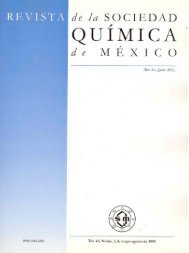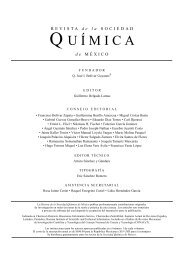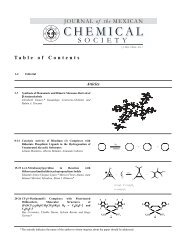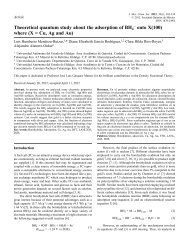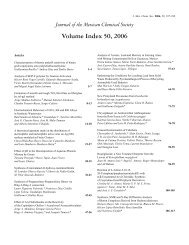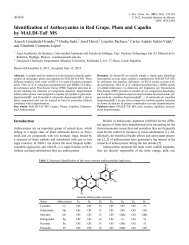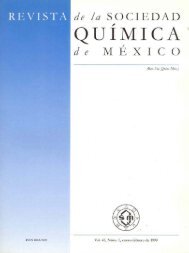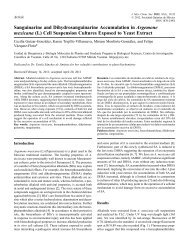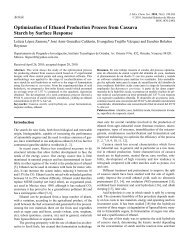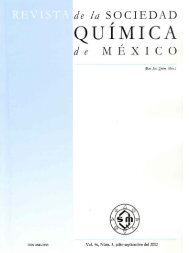SMQ-V047 N-002_ligas_size.pdf - Journal of the Mexican Chemical ...
SMQ-V047 N-002_ligas_size.pdf - Journal of the Mexican Chemical ...
SMQ-V047 N-002_ligas_size.pdf - Journal of the Mexican Chemical ...
Create successful ePaper yourself
Turn your PDF publications into a flip-book with our unique Google optimized e-Paper software.
148 Rev. Soc. Quím. Méx. Vol. 47, Núm. 2 (2003) Peter Kovacic et al.<br />
cal role for ET by Glu imine might also be invoked in this category.<br />
Although ROS at high concentrations induce adverse<br />
effects, OS at low levels may contribute in <strong>the</strong> transmission<br />
process. By analogy, ROS have both beneficial and damaging<br />
effects, depending on various factors, on sperm in <strong>the</strong> fertilization<br />
process [16].<br />
There is general consensus that neurotransmission occurs<br />
by ionic pathways [17]. It should be recognized that ET is not<br />
necessarily incompatible with polar processes. Movement <strong>of</strong><br />
negative electrons (ET) induces an electric field which could<br />
affect <strong>the</strong> migration <strong>of</strong> negative and positive ions, e.g. Cl, Ca,<br />
Na and K, in <strong>the</strong> vicinity. Electrons have been shown to migrate<br />
over substantial distances [18]. Ano<strong>the</strong>r analogy might comprise<br />
movement <strong>of</strong> electrons in a conducting copper wire. The<br />
ET framework may also be applicable to o<strong>the</strong>r neurotransmitters,<br />
such as, nitric oxide [19] and catacholamines [7b].<br />
Metal complexes<br />
Ano<strong>the</strong>r plausible scenario for ET by Glu involves <strong>the</strong> corresponding<br />
metal complexes. This general class <strong>of</strong> ET agents is<br />
omnipresent in <strong>the</strong> major drug and toxin categories [1-7].<br />
There is <strong>the</strong> favorable feature generally <strong>of</strong> quite positive<br />
reduction potentials which energetically favor ET in vivo.<br />
Since <strong>the</strong> α-aminoacid moiety is a facile chelator, metal derivatives<br />
(3) are well documented [20].<br />
Similarly metal chelates (4) <strong>of</strong> <strong>the</strong> α-imino metabolites<br />
should also be considered. Hence, it is conceivable that such<br />
complexes 3 and 4 might participate in toxicity and/or transmission.<br />
Possible involvement <strong>of</strong> cyclic analogs in physiological<br />
activity is discussed in <strong>the</strong> subsequent section.<br />
Cyclic α-iminocarboxylic acids<br />
Prior literature contains various reports on participation <strong>of</strong><br />
<strong>the</strong>se species in physiological activity from <strong>the</strong> ET viewpoint.<br />
ß-Lactams inactivate bacterial cell wall enzyme by covalent<br />
binding. Little attention has been given to <strong>the</strong> fact that a-<br />
iminocarboxylic acids, e.g., 5 from cephalosporins, arise in<br />
<strong>the</strong> process [21].<br />
HO 2 C<br />
In relation to bioactivity <strong>of</strong> ∆ 2 -thiazoline-2-carboxylate<br />
(8), this compound in <strong>the</strong> category has been <strong>the</strong> object <strong>of</strong> most<br />
attention [22]. Hypo<strong>the</strong>ses have been advanced that it is an<br />
intracellular messenger for insulin, and an effector <strong>of</strong> diverse<br />
metabolic activities, such as diuretic response and cell growth<br />
[23]. Also, it is a potent inhibitor <strong>of</strong> dopamine-ß-hydroxylase<br />
[24], a metalloenzyme responsible for producing norepinephrine.<br />
Compound 8 possessed electron affinity compatible with<br />
ET in vivo [21]. Alternatively, all ligands (6-8) in this category<br />
are expected to be avid chelators <strong>of</strong> metal ions in <strong>the</strong> biological<br />
milieu, forming complexes <strong>of</strong> type (9). Cu and Fe<br />
chelates with (6) and (8) exhibit quite positive reduction<br />
potentials [22]. The role <strong>of</strong> ET-OS in eliciting a variety <strong>of</strong><br />
physiological responses from metal complexes is discussed<br />
elsewhere [1-7a].<br />
N<br />
-O<br />
N<br />
8<br />
HO 2 C<br />
6 7<br />
S<br />
O<br />
A related chelator is pyridine-2-carboxylic acid [25],<br />
whose anticancer activity has been attributed to redox cycling<br />
entailing OS by a derived metal complex [26].<br />
Conformational Restriction and Bioactivity<br />
The relatively high activities <strong>of</strong> kainic (10) [27] and domoic<br />
(11) [28] acids in neurotransmission have been attributed to<br />
conformational restriction [29] imposed by <strong>the</strong> cyclic structures.<br />
Just how this property translates into improved activity<br />
is unknown.<br />
n +<br />
N<br />
M<br />
N<br />
O<br />
9<br />
S<br />
O<br />
EO<br />
NHCOR<br />
S<br />
O<br />
N<br />
CO 2 H<br />
5<br />
Model compounds, such as 6 and 7, displayed favorable<br />
reduction potentials, raising <strong>the</strong> possibility <strong>of</strong> ET participation<br />
by 5 in vivo subsequent to site binding, both in toxicity and in<br />
antibacterial action. The values increased with decreasing pH<br />
in line with formation <strong>of</strong> conjugated iminium which conceivably<br />
might be an actor in <strong>the</strong> physiological manifestations.<br />
It is indicative that thiazolidine-4-carboxylic acid undergoes<br />
dehydrogenation in vivo to <strong>the</strong> corresponding α-imino<br />
acid (7) [22]. By analogy, 10 and 11 would be converted into<br />
derivatives <strong>of</strong> 6 which has favorable properties for ET in biosystems.




